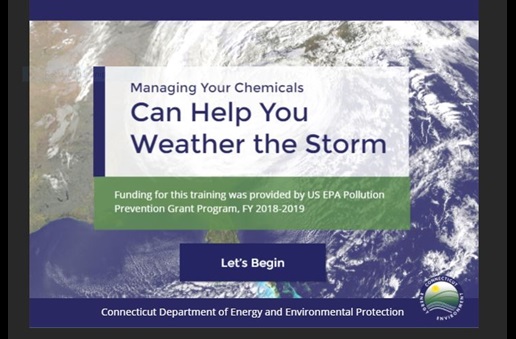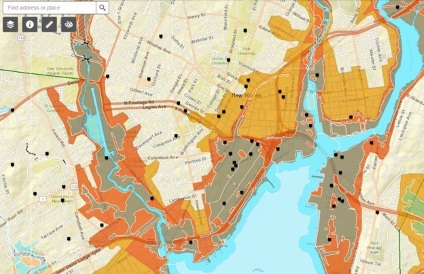Chemical Management and Climate Resilience

CT’s businesses can be prepared to "weather the storm"
Connecticut was hit with at least 5 major storms plus lesser weather events since 2010. It is important to make your business and property resilient to natural hazards and reduce the risk of on-site chemicals causing pollution. Storm events can result in property damage, loss of inventory, and environmental contamination and liability. Accidental releases of toxic chemicals have also put communities and emergency responders at risk. Working together, businesses and local emergency officials can increase awareness and take steps to reduce risk and protect human health and safety. Use the resources below to be better prepared.
1. Take CT DEEP's Free on-line Training
The 21st Century Resilient Business: How Managing Chemicals Can Help Your Business Weather the Storm - Designed to help a variety of businesses, especially those in flood prone areas that use chemicals in their process, sell chemicals and store hazardous waste onsite, including service providers and retail stores that sell toxic products. It provides steps businesses can take to reduce risks and prevent damage, contamination, and liability and keep your business operating. Examples of actions some CT facilities/businesses have already taken are included. (Approximately 20 minutes)- CT DEEP online training course catalog available through UConn Center for Land Use and Education Research
- CT DEEP's Pollution Prevention training - The 21st Century Resilient Business (see Videos section below to watch the course as a YouTube video).

2. Watch Videos with Information from CT Businesses:
If your business or facility has hazardous materials, chemicals or waste on site you'll want to watch this!
Come along on site-visits to a business and a facility, both located in flood prone areas along CT's coast, to find out what changes they are making towards becoming disaster resilient. They offer ideas and examples that you can incorporate at your site.
- U.S. Naval Subase, Groton, CT, Disaster Resiliency - Can Your Facility Weather the Storm?
The U.S. Naval Subase is an outstanding example of preparedness. Some of the actions they have taken include elevating equipment and materials, using floodgates and having a plan of action. - Marina located along CT's coast - Can Your Business Weather the Storm?
A local full-service marina and boat repair business has implemented a variety of actions to protect the environment including a daily walk-through, connecting with local emergency responders and more. - The 21st Century Resilient Business: How Managing Chemicals Can Help Your Business Weather the Storm - training course available as a video with closed captioning and follow up survey.
3. Use Tools, Outreach Materials & Resources for Businesses:
CT Toxics Users and Climate Resilience Map

The CT Toxic Users & Climate Risk Viewer is a tool for businesses as well as local and state emergency preparedness and response planners. Layers include
- the national flood hazard zones,
- hurricane evacuation areas,
- facilities that are EPCRA Tier 2 filers,
- RCRA hazardous waste generators,
- storage/ disposal facilities, and
- Toxic Release Inventory reporters.
A layer with sea level rise will be added in the future.
Business, especially those that store hazardous chemicals, materials and/or wastes on site can assess the vulnerability of their location to climate-related natural hazards and take action to prevent damage or contamination from toxic on-site materials.
EPCRA-regulated facilities subject to CGS 22a-610(e) can assess risk and update hazard mitigation plans and applicable evacuation plans accordingly.
Guidance Documents:
- The Resilient 21st Century Business: How Managing Chemicals Can Help Your Business Weather the Storm - find out what steps you can take to become a disaster-resilient, prepared business.
- How Retailers & Service Providers Can Manage Chemical Products to Weather the Storm - many of the products your business uses, stocks, or sells may contain chemicals. Find out what steps you can take to manage these products and become a disaster-resilient, prepared business.
Local, Regional, and State Emergency Planning:
Municipalities and regions can utilize their Natural Hazard Mitigation Plans (NHMP) to promote best management practices to prevent pollution from chemical releases from businesses in the event of a natural hazard. NHMPs that are due for an update can include new initiatives aimed at chemical management, utilize DEEP's information and promote through municipal websites and social medial.
Natural Hazard Mitigation Plans with chemical management initiative:
- State of CT 2019 Plan update
- Capitol Region 2019 Plan update
- South Central Region 2018 Plan update
- Metro COG 2019 Plan update
DEEP offers to meet with/make presentations for COGs, municipalities, LEPCs and other emergency response officials, business associations and others to provide detailed information about our project, promote outreach materials and training and provide technical assistance.
- Resilient Communities & Businesses: Preventing Pollution from Chemicals - Presentation for CRCOG LEPC 4/2019
- Resilient Businesses: New Tools to Prevent Pollution - Presentation to SERC, 9/17/20
- Managing Your Chemicals Can Help You Weather the Storm - Presentation to SWEP, Oct 2020
Other Resources & Links:
- Are Hazardous Chemical Facilities Prepared for More Natural Disasters Due to Climate Change? - July 2022, slides from webinar presented by US Government Accountability Office, and the ACS Advocacy
- See related information and report: Chemical Accident Prevention: EPA Should Ensure Regulated Facilities Consider Risks from Climate Change | U.S. GAO. The report looked at facilities that are under EPA’s Risk Management Plan (RMP) Rule; this rule is related to Clean Air Act and only applies to facilities that have chemicals that get released into the air.
- See related information and report: Chemical Accident Prevention: EPA Should Ensure Regulated Facilities Consider Risks from Climate Change | U.S. GAO. The report looked at facilities that are under EPA’s Risk Management Plan (RMP) Rule; this rule is related to Clean Air Act and only applies to facilities that have chemicals that get released into the air.
- New Tool ASFPM Helps Property Owners Understand and Lower Flood Risk
- Rising Waters: Planning for Flooding in CT - 14 minute video
- The Torrent - A CT DEEP newsletter exploring floodplain management issues - Subscribe to The Torrent
- CT DEEP Climate Change information
- State Emergency Response Commission
- Additional viewers to assess risk: FEMA Flood Zone Viewer, Flood IQ Flood Depth Viewer, NOAA Sea Level Rise Viewer
- US Climate Resilience Toolkit
- Nature-Based Mitigation Goals and Actions in Local Mitigation Plans
- FEMA www.Ready.gov program and Ready Business
- Flood Smart
- SBA on Buying Insurance
- Resilient Nashua Toolkit
- Climate Change and Extreme Weather Events, November 2019 webinar - Collaboration on Health and the Environment
- Ready Business Toolkit, video
- CT Insurance Department - Disaster Preparednessand Recovery
Last updated January 2023

